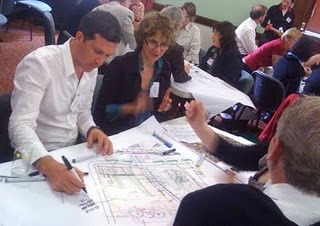Howard Jones, pioneering Green activist of the NSW south coast stood up at the annual Raspberry Day get-together this year and said, in his rich, thoughtful voice: “Copenhagen isn’t really about climate change. It’s about cooperation.” Nice.
I witnessed a marvellous case study in cooperation – at a somewhat smaller scale – when asked to facilitate an intensive day of multi-disciplinary planning by Housing NSW this year. The aim was to figure out how to green the public housing estate in NSW: 60,000 dwellings covering 70,000 hectares (and some are awfully bleak).
We had 40 participants from a rich mix of professions – architects, landscape designers, community renewal staff, sustainability gurus, Housing NSW managers, community gardens facilitators – a smorgasbord of jargons and perspectives (but don’t ask me where the public housing tenants were…we obviously can’t achieve perfection overnight!)
The day began with the Minister for Housing, David Borger, saying his goal was to make public housing estates “places you’re proud to live in and happy to come home to.” (deftly expanding the ambit of “sustainability” into the social realm…where it absolutely belongs, after all: no grass-roots buy-in, no sustainment).
Next came 2 hours of inspiring 15 minute talks. Then we split the room into mixed teams of 5-6, each with a facilitator, and gave them a pile of plans and coloured pens. Two hours of brainstorming and mad scribbling later and we had 6 exciting plans for greening different kinds of housing estates.
At the plenary session, well-known sustainability guru, Michael Mobbs, was the spokesman for the team dealing with one big, grim, western suburbs estate.
He reported how each profession made its unique contribution to the plan:
– the architects showed how joining two roads and transforming a rough footpath could make it easy for tenants to navigate the estate;
– the landscape designers spotted two disused tennis courts along the footpath that could become a community garden and meeting place, shaded by a dense grove of trees;
– Michael Mobbs then explained how the temperatures in those areas could be cooled by 10 degrees in summer by water tanks and evaporation pools(!); and
– the community renewal manager showed how framing the changes around the tenants’ hot issues (crime and isolation) could bring them into the planning process;
Then the council guy finally piped up and said, more or less, “that won’t work because the road is too narrow and the council garbage trucks will just knock those trees down.” Michael Mobbs’ response was “well we’re just going to have to have that discussion with council’s waste services manager” – illustrating perfectly how making change means continually expanding the conversation.
So, can we successfully bring together diverse professions with different strengths to plan together? And can their results vastly exceed what any single profession could achieve? The answer is “yes”.

